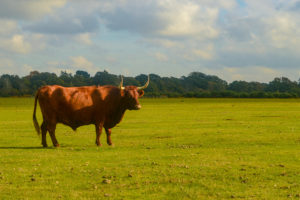 The New Forest cattle are almost as widespread as their slightly more famous fellow residents, the New Forest Ponies. Like the ponies, the cows also call this beautiful New Forest landscape their home and you are very likely to see them in the summer months when they are out grazing in the woods and on the heathland.
The New Forest cattle are almost as widespread as their slightly more famous fellow residents, the New Forest Ponies. Like the ponies, the cows also call this beautiful New Forest landscape their home and you are very likely to see them in the summer months when they are out grazing in the woods and on the heathland.
There are about 3,000 cattle which graze the forest during the summer and people known as Commoners release them during this time as they have rights to depasture their animals on these lands.
Like the New Forest ponies, the cows are removed from the open forest during Autumn as they are susceptible to poisoning from the fallen green acorns if they eat too many of them. Some breeds of cattle however are grazed on the land during the cold, wet winter months as only a few are hardy enough to withstand this time of year in the forest.
There are around a dozen various breeds of cattle which make the New Forest their home, including the impressive looking Highland Cattle. This breed is much more resilient to the colder temperatures than your average Friesian cow, due to its ancient Scottish heritage and they can often be found in the Brockenhurst area. Other breeds which reside in the forest and on the moors include the hardy Galloway and Hereford cross breeds, which can also tolerate the harsh New Forest winter months.

Where Can I See the New Forest Cattle?
Apart from seeing them whilst driving around the New Forest National Park, one of the best ways to see cattle is by taking a walk along some of the lovely New Forest walking routes. There will be plenty of opportunities to spot them grazing on the heathland, in the woods or taking a drink at one of the New Forest’s many watering holes.
Gentle and shy in nature, cows are usually harmless creatures, but its well known they can be very protective of their young. It would be wise to always keep a safe distance. Some breeds have large horns, like the Highland cattle for example and can cause serious injury if the animal feels threatened. Aggression from cattle is rare, but a cow which has recently given birth will likely defend its calf so please keep yourself and dogs well away to avoid causing distress to the mother.
Sometimes Calves are born in the forest, but in general its often recognised that commoners will usually get their cows back to the holdings before they are due to calve just in case of any problems. However, once the young calf is old enough, they are released back out into the forest to be with their mothers. Its reassuring to know that bulls are not allowed to roam in the forest.

New Forest Friendly Visitor
The National Park is a great place to visit and by being a Forest friendly visitor you can help retain that.
For their safety and your own, please leave the animals alone. Even though owned and cared for by local people called “commoners”, they are unpredictable and best treated as wild. Please do not feed or touch them, there is plenty of natural food and it’s best that they don’t come to rely on people’s attention. They may look friendly but they can bite and kick, especially when with young.
Cows roam the New Forest freely and will often step out in front of traffic with no warning, it is important that you slow down whilst driving through the Forest and that you are aware of any wildlife around you.
Unfortunately, accidents involving cattle do happen. Be sure to carry an animal emergency hotlines card which will give you all the information you need if an accident does happen. Please be aware it is an offence to drive away after a collision and not report it!
We hope you enjoy the wonderful area and get to see the New Forest cattle, although not very well recognised, they provide such an important part of the ecosystem that makes up this beautiful part of Hampshire.
